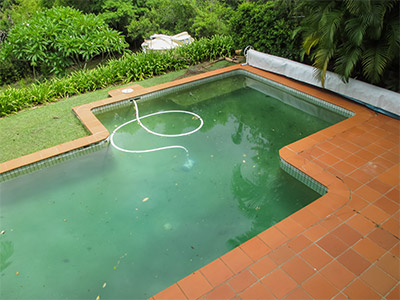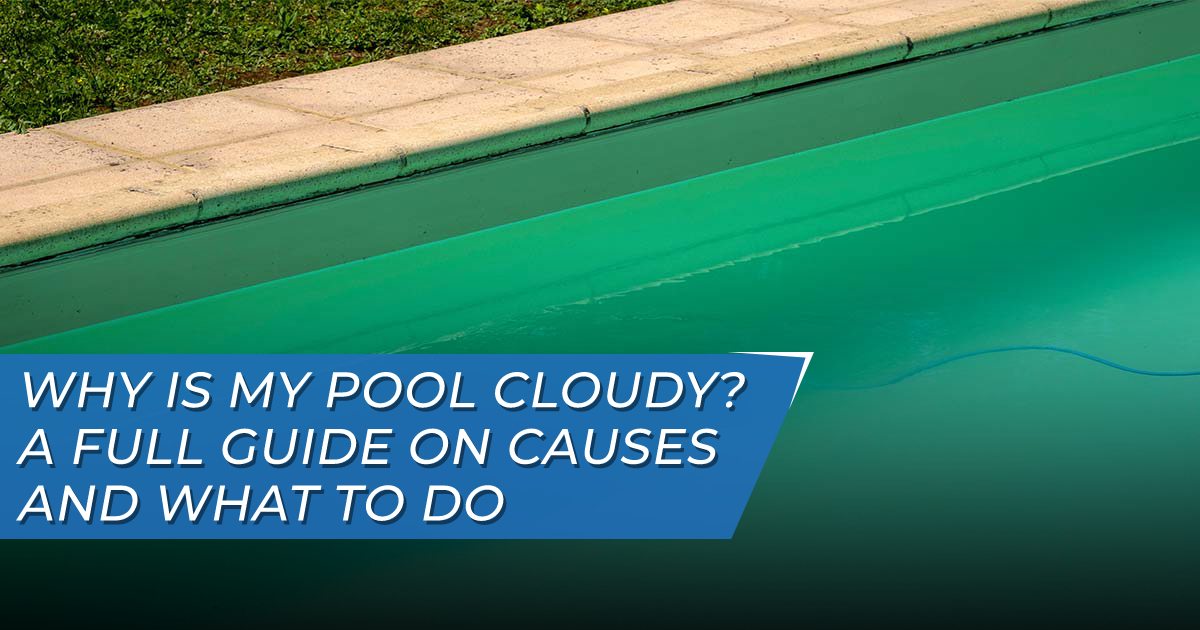Why is My Pool Cloudy? A Full Guide On Causes and What To Do
Why is my pool cloudy? You might be asking yourself this question but just imagine all the dirt, oil, and grime that can end up in the pool water and you’d surely know why. As particles accumulate over time, your pool becomes more susceptible to clouding, making it a major health hazard.
Examining the consistency of your pool water is important in making sure that your pool is clean and swim-ready. As a guide, below are the main causes of cloudy pool water, along with some of the steps you should take to get your pool back to its glory days.
Related Article: How to Maintain a Swimming Pool: Getting the Chemistry Right
Answers to “Why is My Pool Cloudy?”
According to experts, cloudy pool water is predominantly caused by physical problems. As people get into the pool, the water becomes a home not just to pathogens, but to hair, skin, fabric, oil, grime, and bodily fluids. Add to that, based on a study conducted by the Center for Disease Control, an average person can leave around 0.14 grams of fecal matter in the water in as fast as 15 minutes. What’s more? Even when the pool is seldom used, it can still get cloudy due to the accumulation of dust, pollen, and other particles that are carried by air.
Other major factors that can severely affect the clarity–and overall cleanliness–of your pool include the following:
High Calcium Hardness
The amount of calcium dissolved in your pool water greatly impacts how soft or hard your pool water is. The ideal calcium hardness level is somewhere between 150 to 400 ppm. Once it gets too high, the water becomes hard, which can consequently lead to cloudiness and to calcium buildup not just in the pool water, but in the pool plumbing as well.
What to do: If your calcium hardness level is over 400 ppm, you could either use an additive called flocculant or drain water from your pool and replace it with fresh water. If you choose the latter approach, you might have to drain around ¼ of your pool water, depending on how high your calcium hardness level is. It’s important that you drain enough water to get the calcium out of your pool, so it’s best that you ask professional service providers so you can get a rough estimate of how much water you need to drain and how much it would probably cost you. After replacing the water, wait for 6 hours before retesting your calcium hardness level.
Low Chlorine Level
Chlorine acts as a potent disinfectant. Over time, its level, along with its efficiency, decreases due to the accumulation of germs, pathogens, and fecal matter in the pool water. As the chlorine level gets low, it becomes less effective in removing dirt, which causes cloudiness.
What to do: Since chlorine levels also deplete due to direct sunlight, outdoor pool owners are advised to invest in a chlorine stabilizer to prevent chlorine levels from significantly dropping. If your chlorine level reads more than 0.5 ppm, you need to shock your pool–a procedure that we will be discussing more in-depth later on.
Related Article: How To Shock a Pool: A Step By Step Guide
Imbalanced Alkalinity Level
The body can produce acid, which is naturally secreted through sweat. Plus, chemicals from soap, sunscreen, and other products used before and during your swim can also contain acid. As you take a quick dip, you also leave all these secretions and chemicals in your pool water, which then affects its alkalinity level. Once the pool water’s alkalinity level rises, the pool becomes a breeding ground for algae and causes calcium buildup–both of which greatly affect water clarity.
What to do: Always monitor your pool’s alkalinity level and make sure it’s at around 80 to 120 ppm. The ideal pH level for pool water, on the other hand, is 7.0. If the alkalinity level is too high, balance it out by evenly diluting and distributing muriatic acid in the pool water. Then, naturally aerate it and take alkalinity readings after 6, 24, and 48 hours. If you can’t bring it down to its normal range, you can use an air compressor for aeration. If it still doesn’t work, ask for help from professionals.
Water Temperature
Water temperature significantly affects the breakdown of chlorine. For one, bacteria thrive in warm temperatures. As bacteria breed and multiply, free chlorine is used up more quickly, which affects chlorine levels. Ideally, the pool water’s temperature should be kept between 78° to 82°F. If you own a heated pool, regularly run a test to check its chlorine level.
What to do: Since the climate is uncontrollable, there’s really nothing drastic that we can do about your water temperature. But if you really want to try to cool down your pool water, you can invest in a reverse-cycle heat pump, which uses a refrigerant for water temperature control. Or better yet, just monitor your pool’s chlorine levels, especially during hot summer days.
Poor Circulation
Chemical balance, proper filtration, and proper circulation are equally important factors in pool maintenance. Once the water goes stagnant, germs proliferate, leading to the development of algae and cloudy pool water. Circulation can be affected by pump size, pool size, and dead spots where water isn’t able to move freely.
What to do: There’s no need to stress the importance of finding the right pump size for your pool size. If the pump is too small, it wouldn’t facilitate adequate circulation. But aside from the pump size, you should also check if your return jets are positioned properly. If you only invested in one return jet, it’s best that you place it opposite your skimmer, facing downwards. Also, if you cannot run your pump for 24 hours (which is the best practice for pool owners), run it for at least 12 hours, especially during the summer.
Poor Filtration
Different types of filters serve a variety of purposes. Once the filtration system gets faulty due to debris buildup or calcification, the pool water can become cloudy.
What to do: Different filtration systems require specific interventions. Other than clearing any blockage that can affect the performance of your filter, you should also make regular backwashing a habit so you can get the best out of your system. If you own a sand filter or a Diatomaceous Earth (DE) filter, check if you need additional sand or DE.
Related Article: Pool Filter Maintenance 101: What Every Pool Owner Should Know!
How to Clear a Cloudy Pool with Super Chlorination
 Since there are several factors that contribute to cloudy pool water, it’s important that you first identify the root of the problem. There’s no use concentrating on your filtration system if you’re having problems with your pool’s chlorine level, and vice versa. This explains why we have laid down some of the specific steps you need to undertake in clearing your pool water.
Since there are several factors that contribute to cloudy pool water, it’s important that you first identify the root of the problem. There’s no use concentrating on your filtration system if you’re having problems with your pool’s chlorine level, and vice versa. This explains why we have laid down some of the specific steps you need to undertake in clearing your pool water.
Now, one of the best ways to clear your cloudy pool is to perform a non-chlorine shock oxidation treatment or super chlorination, which breaks down different types of contaminants present in your pool water. Plus, it also disintegrates combined chlorine–a foul-smelling mixture of pool disinfectants and nitrogen compounds that smells like strong chlorine.
Below are some of the steps that can help you properly perform super chlorination:
- Since direct sunlight speeds up chlorine breakdown, you should start super chlorinating your pool before sunset. Remove everything in the area, including toys and accessories.
- Get rid of any debris on the pool and scrub visible dirt so you can get the best out of the procedure.
- Chlorine’s efficiency is affected by your pool’s pH level. Before starting the treatment, test your pool water’s pH level and lower it to around 7.0 – 7.2.
- Once the pH level is down to its ideal range, begin the treatment by adding the amount of chlorine recommended by the product manufacturer. For instance, if you’re using calcium hypochlorite, the ideal ratio is at around 1 pound per 10,000 gallons of pool water. Slowly work your way around your pool to make sure all areas are covered.
- Scrub pool sides and other areas where dirt and grime may be present. Use a pool brush or a broom, and be sure to wear gloves while scrubbing the area.
- Allow the substance to work for a few hours. To get an idea of how long you need to let the product work on your pool, read the product’s label.
- Check your pool’s free chlorine level and make sure it’s around 1 – 4 ppm before use.
- Lastly, for best results, add a pool water clarifier, which works by eliminating particles that are too small to be filtered.
If you aren’t sure if you’re on the right track or you still can’t get rid of your cloudy pool water after taking extensive measures, it’s best that you call professionals who can assess the overall condition of your pool. If you need assistance with pool cleaning and maintenance, don’t hesitate to contact us.

